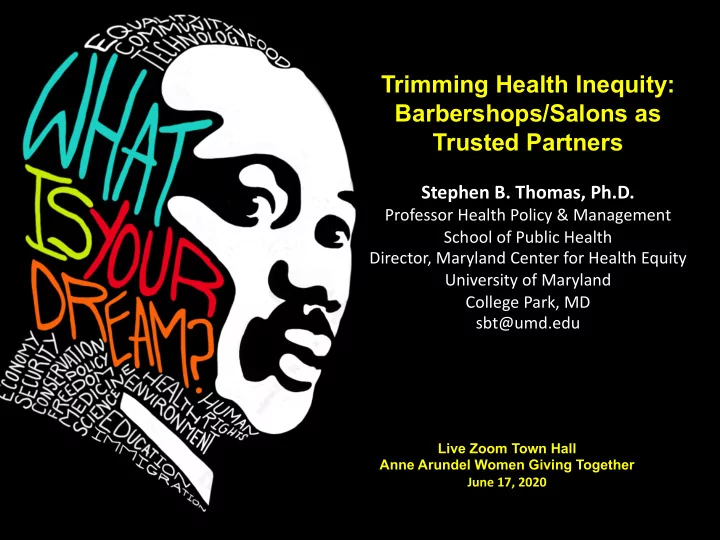

Trimming Health Inequity: Barbershops/Salons as Trusted Partners Stephen B. Thomas, Ph.D. Professor Health Policy & Management School of Public Health Director, Maryland Center for Health Equity University of Maryland College Park, MD sbt@umd.edu Live Zoom Town Hall Anne Arundel Women Giving Together June 17, 2020
Fred Spry, Dr. T and Mike Brown
The Social Context of Health Disparities The ultimate aim is to uncover social, cultural and environmental factors beyond the biomedical model and address a broad range of issues. This approach includes, but not limited to, breaking the cycle of poverty, increasing access to quality health care, eliminating environmental hazards in homes and neighborhoods, and the implementation of effective prevention programs tailored to specific community needs.
The Historical Context of Health Disparities “..If there is no struggle , there is no progress. Those who profess to favor freedom, and yet depreciate agitation, are men who want crops without plowing up the ground. They want rain without thunder and lightning. They want the ocean without the awful roar of its many waters…” (Fredrick Douglass)
SCHOOL OF PUBLIC HEALTH § CENTER FOR HEALTH EQUITY Defining Health Disparities and Health Equity National Institute of Minority Health and Health Disparities and Office of the Director, National Institutes of Health American Reinvestment and Recovery Act RC2MD004766; Principal Investigators: Sandra Quinn & Stephen Thomas
The words we use can matter. Definitions can matter: While some differences in definitions may reflect only stylistic preferences, others convey values and beliefs that can be used explicitly or implicitly to justify and promote particular views, policies, and practices.
“Health equity means that everyone has a fair and just opportunity to be as healthy as possible...”
For the purposes of measurement, health equity means reducing and ultimately eliminating disparities in health and its determinants that adversely affect excluded or marginalized groups .
… if an effort does not address poverty, discrimination, or their health- damaging consequences for groups of people who have historically been excluded or marginalized – it’s probably not a health equity effort .
IMAGINE two men of the same age in the United States standing together on a Metro platform in Washington, D.C., heading to their respective homes. One boards a train that takes him to Montgomery County, Maryland. The other rides a train to his home in Prince George’s County, Maryland. The men live just ten miles from each other. Can you predict how long each will live based on where the subway stops?
Life Expectancy by Metro Stop
SCHOOL OF PUBLIC HEALTH § CENTER FOR HEALTH EQUITY History Matters National Institute of Minority Health and Health Disparities and Office of the Director, National Institutes of Health American Reinvestment and Recovery Act RC2MD004766; Principal Investigators: Sandra Quinn & Stephen Thomas
SCHOOL OF PUBLIC HEALTH § CENTER FOR HEALTH EQUITY U.S. Public Health Service Syphilis Study done at Tuskegee (1932-1972) The Tuskegee Syphilis Study, described as arguably the most infamous biomedical research study in U.S. History A doctor draws blood from one of the Tuskegee test subjects National Institute of Minority Health and Health Disparities and Office of the Director, National Institutes of Health American Reinvestment and Recovery Act RC2MD004766; Principal Investigators: Sandra Quinn & Stephen Thomas
“…The people who ran the study at Tuskegee diminished the stature of man by abandoning the most basic ethical precepts. They forgot their pledge to heal and repair. They had the power to heal the survivors and all the others and they did not. Today, all we can do is apologize.…” President William Jefferson Clinton The White House May 16, 1997 http://www.cdc.gov/tuskegee/clintonp.htm
Cultural Memory
SCHOOL OF PUBLIC HEALTH § CENTER FOR HEALTH EQUITY INNOVATIVE COMMUNITY ENGAGEMENT Photo Credit: Sandra Quinn National Institute of Minority Health and Health Disparities and Office of the Director, National Institutes of Health American Reinvestment and Recovery Act RC2MD004766; Principal Investigators: Sandra Quinn & Stephen Thomas
Cultural Tailoring Matters
Linnan, L., THOMAS, S., D’Angelo, H., & Ferguson, Y. (2012). African American barbershops and beauty salons: An innovative approach to reducing health disparities through community building and health education In M. Minkler (Ed.), (3 rd Edition) . New Brunswick, NJ: Rutgers University Press. THANK YOU CIGNA !!!
VIDEO VISIT https://go.umd.edu/5GR
https://sph.umd.edu/center/che/make-gift
Fred Spry, Dr. T and Mike Brown
Trimming Health Inequity: Barbershops/Salons as Trusted Partners Stephen B. Thomas, Ph.D. Professor Health Policy & Management School of Public Health Director, Maryland Center for Health Equity University of Maryland College Park, MD sbt@umd.edu Live Zoom Town Hall Anne Arundel Women Giving Together June 17, 2020
Recommend
More recommend